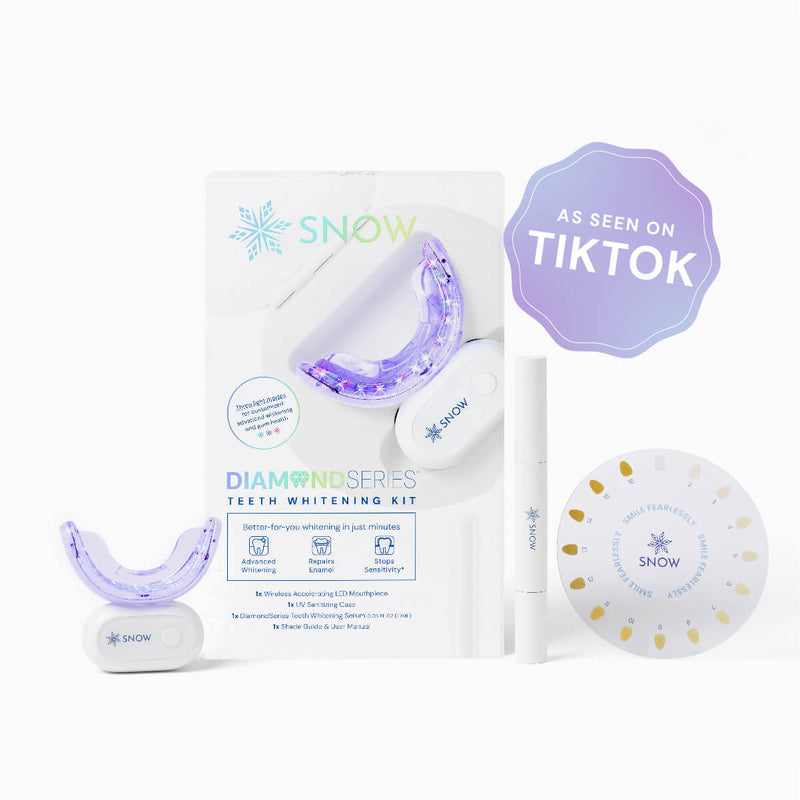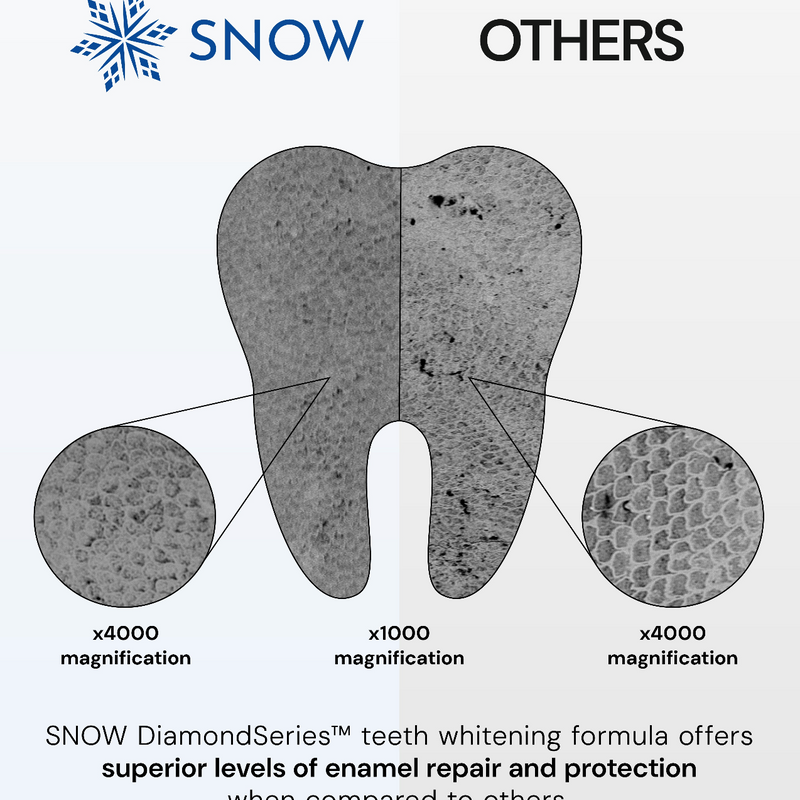You've seen the television commercials and social media messages. Teeth whitening strips are all over social media and have been around for a while, but do they work?
It's all in the details, including how you apply whitening strips and how your natural teeth react to the ingredients in whitening products.
This article will cover the fundamentals of teeth whitening and help you decide whether whitening strips are the best solution for you.
What Is the Purpose of Teeth Whitening Strips?
One of the most popular and cost-effective at home teeth whitening treatments is teeth whitening strips. They are constructed of pliable, squishy plastic (such as polyethylene). This has an adhesive coating to help the strips stick to your teeth.
A whitening gel's other main active ingredient is hydrogen peroxide or carbamide peroxide. These are safe and efficient whitening chemicals that you may use professionally and at home.
Natural teeth whitening strips typically do not include peroxide. Instead, they have ingredients such a essential oils and botanicals to remove stains softly and gradually. These products are safe and gentle. However, they are not as effective as peroxide treatments since natural ingredients are not as potent.
Teeth Whitening 101
Teeth whitening procedures have grown in popularity. In the age of social media, where everything wants to look picture-perfect, a bright white smile has grown in popular demand. Chances are you've seen Instagram influencers promoting teeth whitening treatments in ads or in your feed.
So, why do people spend money on bleaching gels and whitening kits to have a brighter smile?
The overwhelming majority of respondents are self-conscious about their appearance. This is not a self-serving statement. Your self-esteem is intricately related to how others see you, and how you view yourself. All key factors that may affect mental health.
You may feel self-conscious about your smile if your teeth are stained, brown, or yellow. Whiter teeth are connected with improved self-confidence. This is why many people pay good money to whiten their pearly whites.
The Benefits of Teeth Whitening Treatments
If you're looking for whiter teeth, thankfully there are several options available on the market available at different price points. It all depends on your needs and budget. Read on, in this post we'll discuss the difference between at home whitening treatments and professional teeth whitening options.
The Most Common Reasons for Teeth Whitening
The majority of teeth whitening strips are efficient in removing surface stains.
When it comes to milestone events and looking your best, having a dental cleaning and professional teeth whitening performed is a popular course of action.
Consult with your dentist before whitening your teeth. Your dentist can ensure that your teeth are in optimal health and they can also provide recommendations if you're worried about tooth sensitivity. When you see a dental practitioner, they can use the whitening dental-grade whitening that are stronger than over- the counter teeth whitening products.
Crest Whitestrips and other at home whitening methods may not be the most effective long-term option for reversing the effects of age or smoking on the teeth. Whitestrips typically remove extrinisic surface stains. If you have deep long-standing stains, it may be better to get your teeth professionally whitened.
Whatever your reason for wanting to try whitening strips, go for it! You're on the right track to a healthy smile. Here are some tips and insights to whiten your teeth.
How to Whitening Strips Work?
Are whitening strips the solution? To begin, consider how any whitening product works.
When you use whitening strips or a whitening gel, these treatments contain hydrogen peroxide or carbamide peroxide. Both of these bleaches work similarly.
The active element, hydrogen peroxide or carbamide peroxide, penetrates through the tooth enamel to the dentin layer. Hydrogen peroxide works faster, while carbamide is more gradual (and gentle since it is a slower process.)
These active ingredients whiten teeth by lifting stains and discoloration.
Is it safe to use teeth whitening strips?
Yes, most whitening strips are a safe technique to remove surface stains when used correctly. The American Dental Association recommends that you use any teeth whitening treatments in moderation.
It is critical that you follow the package instructions. You risk damaging your tooth enamel and gum tissue if you overuse any teeth whitening product.
Teeth Whitening Common Side Effects
Depending on your sensitivity level, it's common to have side effects. Some users experience tooth sensitivity and mild gum irritation or tingling. Since whitening strips trigger salivation, it's common for the ingredients to bleed onto your gums.
Following the directions on the package minimizes your chances of having unpleasant side effects.
Why Do My Teeth Feel Sensitive?
Some people experience sensitivity with teeth whitening treatments.
As the whitener gel enters the dentin, the teeth become more sensitive. The gel may irritate the nerve of the tooth. This usually only lasts during treatment and wears off after a few hours. If the discomfort lasts longer than usual, consult your dentist.
Sometimes irritation and sensitivity occurs if the product is left on the teeth longer than intended. Whitening ingredients can cause tooth damage if they're left on for too long.
If your teeth run sensitive, sometimes professional treatments are the way to go as dentists protect your gums and whiten your teeth faster with potent dental grade bleach agents.
How to Use Teeth Whitening Strips
Every brand is different when it comes to how to use whitening strips. However, the gist is very similar. You put the strips on your teeth and leave them on for an alotted amount of time. To guarantee safe and efficient whitening results, read and follow the directions thoroughly.
The following are the fundamental steps for using at home whitening strips:
- Remove the package's top and bottom strips
- If required, trim the strips to the exact height of your teeth with clean scissors
- Remove the thin coating of plastic that has formed on top of the glue
- Place each strip on your teeth gently. Ensure the strips cover your teeth thoroughly, but don't allow them to contact your gums
- Leave the strips on your teeth for the time specified in the box
- Take off the strips
- Immediately rinse your teeth with water.
- Brush your teeth after at least two hours.
- Repeat as to the package directions.
Before using whitening strips, make sure your teeth are clean. Do not, however, clean your teeth for at least 30 minutes before applying the strips. This may aggravate gum inflammation.
Natural Teeth Whitening
There are still a few options open to you, even if your medical or dental history prevents you from using teeth whitening strips or undergoing professional procedures to lighten the color of your teeth.
It will be easier to keep the top and lower teeth in your mouth white if you avoid certain meals, drinks, and destructive behaviors (including smoking, drinking, and using drugs), such as those mentioned above.
Use toothpaste containing sodium hydroxide or baking soda to gently brighten your teeth' appearance.
Even though these treatments take some time to be effective, they should not harm your gums or enamel.
Other Popular Teeth Whitening Products
There are a lot of different approaches to getting whiter teeth. Let's compare these options to some of the other whitening procedures available.
Toothpaste and Mouthwash
Whitening toothpaste and mouthwashes can potentially eliminate stains that have formed on the surface of your teeth.
They are not, however, influential in removing intrinsic stains. As a result, they could lessen the appearance of stains, but they won't whiten your teeth. Compared to other tooth whitening solutions, they are not nearly as effective.
Products and home remedies that claim to whiten teeth and contain charcoal, acidic fruits, or vinegar have not been proven helpful in clinical trials.
Whitening treatments such as toothpaste, mouthwashes, and at-home remedies have very little to no effect on the color of your teeth.
Teeth Whitening Kits
Whitening strips are not always more successful than teeth whitening kits that may be done at home using LED lights
The first step in the process is using a whitening gel containing hydrogen carbamide peroxide. After that, they turn on an LED light that shortens the treatment duration and lessens the sensitivity of the teeth.
Whitening strips, teeth whitening with LED lights, and professional teeth whitening all produce comparable results.
Whitening kits that may be used in the comfort of one's home come highly recommended by NewMouth due to their efficiency, user-friendliness, and low risk of adverse effects.
The following factors raise the likelihood of undesirable consequences on the body:
- Treatments that need to be carried out on the tooth's surface for an extended period
- Therapies involving the use of peroxide solutions with greater concentrations
- Medications that are placed in direct touch with your gum line
- Overuse or misuse
In-Office Whitening Treatments
Another method that is both secure and efficient for lightening the shade of one's smile is to have one's teeth whitened professionally at a dental clinic. Dentists offer their patients a wide variety of treatment options to choose from. Talk to the dentists in your area to learn more about their procedures.
Whitening strips and LED whitening systems that may be done at home are not nearly as effective as having your teeth professionally whitened. On the other hand, its price is significantly more than the other two options.
FAQs
Do whitening strips work?
Yes, to answer briefly. Teeth whitening strips can function in as little as a few days and can whiten your teeth by one or two shades. However, over-the-counter solutions are frequently less successful than in-office dental whitening procedures. They also have specific dangers, such as increased gum and dental sensitivity.
How long does it take for whitening strips to work?
Typically, they require two weeks of twice-daily application. Last but not least, whitening strips produce immediate effects. After using the strips for a few days, your teeth should start to look whiter, and the results should continue for at least four months.
Are whitening strips worth it?
Generally, yes. Whitening strips are simple to use and cost-effective.
Are whitening strips safe?
To eliminate stains from the teeth, teeth whitening solutions, such as whitening strips, can be helpful and reasonably priced. They are typically safe to use. To prevent negative consequences, individuals must utilize them properly.
Do SNOW teeth whitening strips work?
Snow tooth whitening strips are effective. They whiten teeth in just 15 minutes with the main component, hydrogen peroxide, and disintegrate immediately on your teeth, so you don't have to peel them off. And, unlike other whitening strips, they do not leave any muck or crud behind after removal.
They also employ Snow's unique P3 Technology, which whitens teeth more effectively and quickly than conventional whitening strips.


























